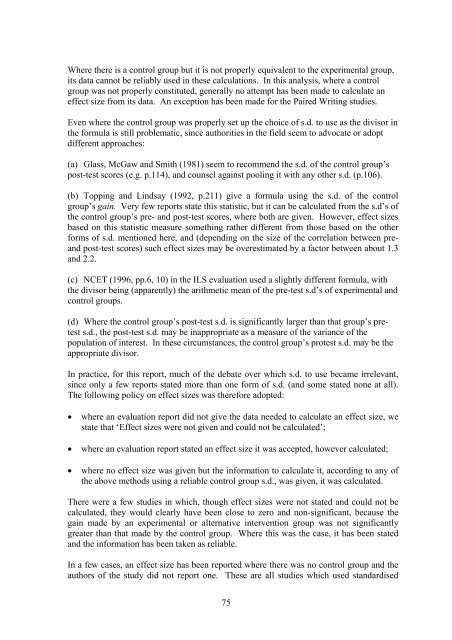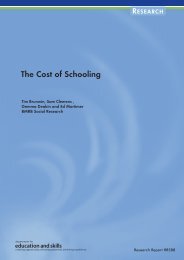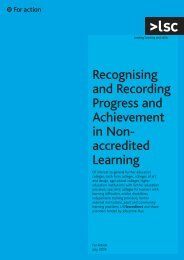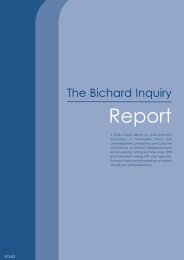What Works for Children with Literacy Difficulties? - Digital ...
What Works for Children with Literacy Difficulties? - Digital ...
What Works for Children with Literacy Difficulties? - Digital ...
Create successful ePaper yourself
Turn your PDF publications into a flip-book with our unique Google optimized e-Paper software.
Where there is a control group but it is not properly equivalent to the experimental group,<br />
its data cannot be reliably used in these calculations. In this analysis, where a control<br />
group was not properly constituted, generally no attempt has been made to calculate an<br />
effect size from its data. An exception has been made <strong>for</strong> the Paired Writing studies.<br />
Even where the control group was properly set up the choice of s.d. to use as the divisor in<br />
the <strong>for</strong>mula is still problematic, since authorities in the field seem to advocate or adopt<br />
different approaches:<br />
(a) Glass, McGaw and Smith (1981) seem to recommend the s.d. of the control group’s<br />
post-test scores (e.g. p.114), and counsel against pooling it <strong>with</strong> any other s.d. (p.106).<br />
(b) Topping and Lindsay (1992, p.211) give a <strong>for</strong>mula using the s.d. of the control<br />
group’s gain. Very few reports state this statistic, but it can be calculated from the s.d’s of<br />
the control group’s pre- and post-test scores, where both are given. However, effect sizes<br />
based on this statistic measure something rather different from those based on the other<br />
<strong>for</strong>ms of s.d. mentioned here, and (depending on the size of the correlation between pre-<br />
and post-test scores) such effect sizes may be overestimated by a factor between about 1.3<br />
and 2.2.<br />
(c) NCET (1996, pp.6, 10) in the ILS evaluation used a slightly different <strong>for</strong>mula, <strong>with</strong><br />
the divisor being (apparently) the arithmetic mean of the pre-test s.d’s of experimental and<br />
control groups.<br />
(d) Where the control group’s post-test s.d. is significantly larger than that group’s pretest<br />
s.d., the post-test s.d. may be inappropriate as a measure of the variance of the<br />
population of interest. In these circumstances, the control group’s protest s.d. may be the<br />
appropriate divisor.<br />
In practice, <strong>for</strong> this report, much of the debate over which s.d. to use became irrelevant,<br />
since only a few reports stated more than one <strong>for</strong>m of s.d. (and some stated none at all).<br />
The following policy on effect sizes was there<strong>for</strong>e adopted:<br />
• where an evaluation report did not give the data needed to calculate an effect size, we<br />
state that ‘Effect sizes were not given and could not be calculated’;<br />
• where an evaluation report stated an effect size it was accepted, however calculated;<br />
• where no effect size was given but the in<strong>for</strong>mation to calculate it, according to any of<br />
the above methods using a reliable control group s.d., was given, it was calculated.<br />
There were a few studies in which, though effect sizes were not stated and could not be<br />
calculated, they would clearly have been close to zero and non-significant, because the<br />
gain made by an experimental or alternative intervention group was not significantly<br />
greater than that made by the control group. Where this was the case, it has been stated<br />
and the in<strong>for</strong>mation has been taken as reliable.<br />
In a few cases, an effect size has been reported where there was no control group and the<br />
authors of the study did not report one. These are all studies which used standardised<br />
75

















